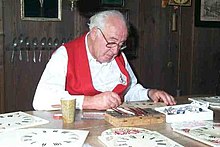Lacquer sign clock
The lacquer shield clock is a clock shape developed in the Black Forest with a painted, mostly arch-shaped wooden shield, which was widely used between 1780 and 1880. It is probably the best-known testimony to home-made watch production in the Black Forest .
History and dissemination
From 1770 the first arched clock shields appeared in the Black Forest, which were painted with oil paint. However, it took almost 30 years for the Black Forest sign painters to find materials and processes to make the wooden lacquer signs attractive and durable. The name Lackschild comes from the invention of the “dry paint” by Kajetan Kreuzer (1780/1790). However, this does not mean, as is often wrongly claimed, the protective conviction of the watch plates. Rather, this sealing of the chalk ground before the signs were actually painted gave the clocks their name. Especially in the first half of the 19th century, clocks with hand-painted wooden signs were the hallmark of watchmaking in the Black Forest.
Like other Black Forest clocks, the Lackschild clocks were exported to numerous countries, including France , England and Sweden , where the Black Forests maintained a dense network of branches. But they also found great sales in more distant countries such as the Ottoman Empire or Russia , from where they reached China .
A special type of Black Forest clock, which was often combined with lacquer signs, is the so-called Black Forest Surrer . It has a 4/4 beat (Grand Sonnerie) and beats every quarter of an hour (first once, then 2, 3 and 4 times) and also beats the current full hour. The name "Surrer" refers to the whirring noise that can be heard particularly well when the clock strikes a low number (1:00 a.m. 15 minutes), as the lever wheel has to return to its starting position after each stroke. Mostly and in older models these works have a vertical porch instead of a horizontal one . These movements do not have a lock washer, which has the advantage that the current stroke sequence can be repeated manually.
Manufacturing
The sign, mostly made of fir wood , was soaked in glue water by specialized sign painters and coated with a primer made of powdered chalk. After drying, several layers of white lead dissolved in turpentine varnish were applied, then the disc was dried and sanded again. The clock numbers were then painted on with a stencil before the other decorative elements were added by hand. Finally, a varnish made of shellac dissolved in turpentine was applied and the shield was polished with a cloth soaked in linseed oil, creating the typical shimmer of varnish. The lacquer sign clocks are available in six sizes, with 5, 7, 9, 10, 11 and 12 face, with the numbers indicating the length or height of the square shield part in inches. They can also be differentiated according to the time after which they have to be rewound, for example there are 12-hour, 24-hour and 8-day clocks, the latter of which appeared around 1830.
layout
For the creative elaboration of the decor, the shield arch was particularly suitable, where floral decorations in particular, but also numerous other representations can be found. Often there are also two or four pillars next to the dial; if these are missing, the corners were usually painted with flower patterns. Because of the mass sales, the paintings are rarely of great quality, although individual clock painters made a name for themselves with their skills. Decals with depictions of landscapes or cities appeared around 1845 . The design of the signs followed fashion trends and often took up current events, such as a sign with a giraffe and two "Moorish figures" that was designed by Charles X in 1827 for the Zarafa giraffe exhibition .
literature
- Herbert Jüttemann: The Black Forest Clock. Klinkhardt and Biermann, Braunschweig 1972, DNB 730053008 .
- Berthold Schaaf: Black Forest clocks. Braun, Karlsruhe 2008, ISBN 978-3-7650-8391-4 .

